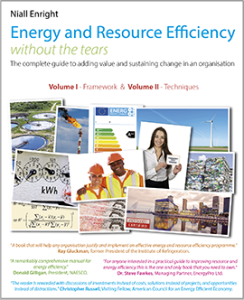Procrastination is opportunity’s assassin. – Victor Kiam
If one were to ask 100 senior managers what they thought of resource efficiency they would probably all agree with the proposition it is a “Good Thing”, like “apple pie and motherhood”. But the data shows us that in the majority of organisations there remains a large un-tapped potential to improve efficiency. It seems that resource efficiency gets stuck on the organisational “to do” list, in limbo, its value un-realised or only part-realised.
In many cases the challenge is not only to convince management about the benefits of resource efficiency but why implementing a program now is desirable. We must accept that there is always some other corporate imperative that can claim greater priority: the big acquisition; the reorganisation; addressing a downturn; the new management system; the expansion; or the new service development.
But how on earth did we get to the assumption that resource efficiency is an either or proposition? “Either I achieve corporate objective A or I implement a resource efficiency program”. We need to mercilessly stamp this notion out wherever it appears, because it is plain wrong. In fact, if we listed corporate objectives A, B, C and so forth, the truth is that resource efficiency will most likely enhance many of these core objectives directly or indirectly.
Let imagine that corporate objective A is to sell more – well we shall see that customers are increasingly considering the environmental attributes of products in their purchasing choices. Is corporate objective A to increase profit? Well energy and raw materials are often the largest or second largest variable cost for many organisations (alongside labour). Also reducing production costs can provide a more competitive price which can increase volumes. Is corporate objective A to produce more products? Well we shall see that energy efficiency, for example, is an excellent form of condition-monitoring of equipment which will directly increase plant reliability. The list goes on and on in this vein. We shall see later that alignment of resource efficiency to established business priorities is an important step in gaining commitment.
Another major stumbling block to gaining commitment is the assumption that the resource efficiency process will use up a disproportionate amount of two limited resources:
- Money (in particular Capital)
- Time ( Human Capital: management time or employee effort)
Neither of these cases is remotely true. It is quite possible to design a resource efficiency programs that is entirely self-funding, requires little Capital, and which delivers value over even the narrow accounting year timescale. In fact we shall see later on page XX that the money for most resource efficiency projects is currently real and available today in the form of the planned expenditure on waste that is an invisible item in many existing budget lines. Resource efficiency is often simply about redirecting this unproductive expenditure to productive use.
As far as effort is concerned, resource efficiency is generally not about working harder but about working smarter. The demand on people’s time is entirely commensurate with the returns. If people are very busy, external consulting support to kick-start a program is available, so the initial “hump” of effort can be easily resourced. In the Author’s experience resource efficiency programs actually invigorate, motivate and energise staff and so add to the effective Human Capital available.
First we will set out the financial arguments for implementing a resource efficiency program, including the financial cases. But of course our decision to act is not in many cases exclusively value-driven and so the following section will set out other reasons why acting now is essential and why we are fortunate to be in a position to be able to make a real difference for generations to come.
So the key is not to delay. Resource efficiency is not an either or proposition, other objectives do not need to be sacrificed and every day that passes is a day where savings are lost and can never be recovered.



0 Comments